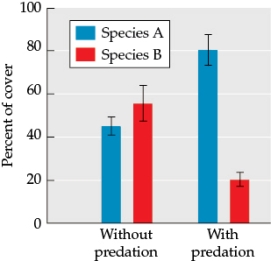Multiple Choice
Refer to the figure.  Suppose you are studying succession patterns in two species, species A and species B, both small aquatic organisms that colonize bare surfaces underwater. You replicated Sutherland's experiments in this new system by placing bare tiles underwater in predator-protected areas and areas with predators. You collect data on the percent of cover for each species, as shown in the figure.
Suppose you are studying succession patterns in two species, species A and species B, both small aquatic organisms that colonize bare surfaces underwater. You replicated Sutherland's experiments in this new system by placing bare tiles underwater in predator-protected areas and areas with predators. You collect data on the percent of cover for each species, as shown in the figure.
- Without predation, which species is a better competitor?
A) Species A is a much better competitor than species B.
B) Species A is a slightly better competitor than species B, but there is a lot of variability.
C) Species B is a much better competitor than species A.
D) Species B is a slightly better competitor than species A, but there is a lot of variability.
Correct Answer:

Verified
Correct Answer:
Verified
Q55: In their studies of succession in Glacier
Q56: Farrell's studies of algal succession on the
Q57: Refer to the figure.<br><img src="https://d2lvgg3v3hfg70.cloudfront.net/TBO1115/.jpg" alt="Refer to
Q58: Sousa's studies of intertidal zones in southern
Q59: Refer to the figure.<br>Figure 9<br> <img src="https://d2lvgg3v3hfg70.cloudfront.net/TBO1115/.jpg"
Q61: Which statement concerning Cowles's early work on
Q62: Assume that a glacier is melting at
Q63: In their manipulative studies of succession in
Q64: Refer to the figure.<br><img src="https://d2lvgg3v3hfg70.cloudfront.net/TBO1115/.jpg" alt="Refer to
Q65: Assume that the melting of a glacier